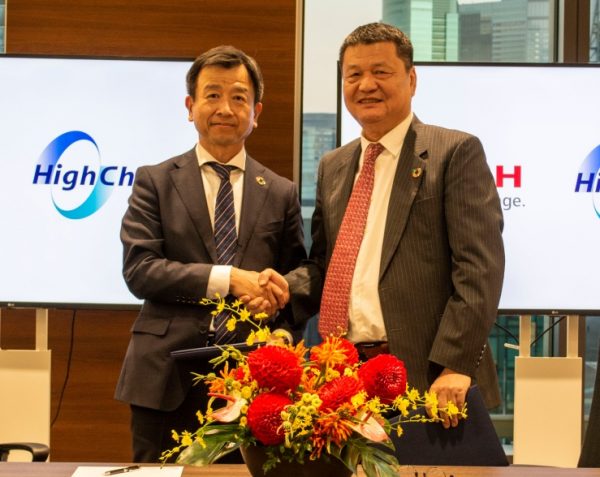HighChem Co., Ltd. (Headquartered in Minato-ku, Tokyo; President: Taka Ushio, hereinafter referred to as HighChem) and Ricoh Company, Ltd. (Headquartered in Ota-ku, Tokyo; President and Executive Officer: Yoshinori Yamashita, hereinafter referred to as Ricoh) are pleased to announce their partnership. Aimed at contributing to the resolution of social issues such as achieving a carbon-neutral society and reducing environmental pollution from microplastics, the companies have agreed to jointly develop a process for the mass production of high molecular PLA (Polylactic Acid) using supercritical carbon dioxide. A memorandum of understanding was signed on November 25, 2021.
Note: High Molecular PLA refers to polylactic acid with a weight an average molecular weight of over 300,000.
(Left) Ricoh Co., Ltd.
Ricoh Futures Business Unit
President Takahiro Irisa
(Right) HighChem Company Limited
Representative Director and President Taka Ushio

What is Ricoh's "High molecular PLA"?
PLA is a plant-based plastic material made from starch found in corn and other crops. Since it does not increase carbon dioxide in the atmosphere when incinerated (carbon neutral), it has a lower environmental impact than fossil-based plastics. In addition, it decomposes into water and carbon dioxide under certain conditions (biodegradable), so even if it is made into microplastic, it will decompose in the natural environment and can be expected to reduce environmental pollution. On the other hand, compared to fossil-based plastics, they have a lower molecular weight and a simpler chemical structure, so they suffer from lower strength and heat resistance. Ricoh has the technology to manufacture High molecular PLA using the plasticization polymerization method using supercritical carbon dioxide that we have cultivated over the years.
What only “HighChem x Ricoh” can do
Purpose of joint development High molecular PLA
The purpose of this joint development is to provide the world with products with higher added value by verifying Ricoh's polymerization technology and prototyping High molecular PLA. In the future, we aim to realize mass production of High molecular PLA. By realizing this joint development, we will be able to improve the quality of the foamed PLA sheet "PLAiR" developed by Ricoh, the quality of the PLA fiber "HIGHLACT™" developed by HighChem. We will also continue to develop applications for engineering plastics with high heat resistance. Furthermore, we would like to expand this high molecular weight technology to other biodegradable resins. This project will be carried out at HighChem 's Tokyo Research Center (Kashiwa City, Chiba Prefecture), Ricoh's Numazu Office (Numazu City, Shizuoka Prefecture), and Ricoh Technology Center (Ebina City, Kanagawa Prefecture).
By combining the technological capabilities that Ricoh has cultivated to date with HighChem 's track record as a "Bridge between Japan and China", we will create a future where we can provide new PLA products that help solve social issues to more people around the world as soon as possible.
Ricoh's strengths in biodegradable plastic
1. Initiatives in “environmental management”
Since 1998, the Ricoh Group has been engaged in "environmental management" that aims to simultaneously preserve the environment and generate profits. In order to realize a decarbonized society, the spread of alternative materials to fossil-derived plastics is an urgent issue. Ricoh uses biomass plastic made from PLA as a component for multifunction devices, and develops and sells "PLAiR", which is made by foaming PLA using proprietary technology.
 PLAiR, a new material made from plants and air
PLAiR, a new material made from plants and air2. Molding technology for biodegradable plastic including PLA
Since PLA is difficult to mold, fossil-derived resins may be mixed in to modify it. This not only negates the benefits of carbon neutrality and biodegradability, but also increases costs due to processing costs, which prevents it from being introduced into the market.
By applying the supercritical carbon dioxide technology that it has cultivated to date to the polymerization reaction of PLA, Ricoh succeeded in producing pellets with increased molecular PLA. Since there is no need to mix additives or other fossil-derived resins, it is possible to suppress the cost increase of molded products, and it is also possible to increase the strength of the material without sacrificing the advantages of PLA, which has a low environmental impact.
HighChem's strengths in biodegradable plastics
1.Providing Total Solutions for biodegradable plastic
HighChem has been proactive in developing the market for biodegradable plastics, including forming a strategic business partnership with BBCA Group, the largest PLA (Polylactic Acid) manufacturer in China. In addition to PLA, HighChem has established a comprehensive import system for a total of seven types of biodegradable plastics, such as PBAT (Polybutylene Adipate Terephthalate) and PHBV (Polyhydroxybutyrate-co-hydroxyvalerate), enhancing its role as a total solutions provider in the biodegradable plastics industry. This strategic alignment underlines HighChem's commitment to expanding its environmental footprint and leading innovation in sustainable materials.
2. Developing the PLA fiber market
On December 1, 2021, HighChem unveiled its innovative next-generation PLA material, HIGHLACT™, realized through the CHEMTEX framework (CHEMICAL = HighChem's expertise in chemistry × TEXTILE = Japan's superior traditional weaving and dyeing techniques). HIGHLACT™ achieves enhanced quality of PLA fibers through integrated production management from raw resin to fabric, targeting market development with apparel manufacturers. Leveraging its market development capabilities nurtured as a "Bridge between Japan and China", HighChem is set to expand its presence in the biodegradable plastics market globally, starting with China. This strategic move aligns with HighChem's goal to pioneer sustainable material solutions worldwide.
 HighLact™ fabric
HighLact™ fabricRicoh Company, Ltd.
Company name: Ricoh Company, Ltd.
Location: 1-3-6, Nakamagome, Ota-ku, Tokyo
President & CEO:Yoshinori Yamashita
Business Company name: Ricoh Company, Ltd.
HighChem Company Limited Outline
Company Name: HighChem Company Limited
Location: Minato-ku, Tokyo 3-1, Toranomon 1-chome, Tokyo Toranomon Global Square 11F
Representative Director: Taka Ushio
Business: Export/import and sales of Chemicals / outsourced manufacturing / Technology Licensing related business / manufacture and sales of catalysts / Biodegradable Materials import and sales, etc.
[Inquiries from media organizations regarding this release]
HighChem Company Limited Public Relations: Kuroiwa (090-6539-4213)
TEL: 03-5251-8580 E-mail: koho@highchem.co.jp
Ricoh Co., Ltd. Public Relations
TEL: 050-3814-2806 E-mail: koho@ricoh.co.jp
URL: https://jp.ricoh.com/
